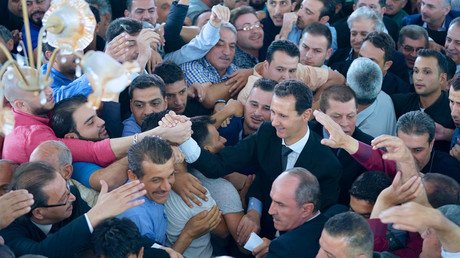Bishopsgate bomb 25yrs on: New photos show devastation of a crime never solved (PHOTOS)
On April 24, 1993 Bishopsgate, in London’s financial hub, was the scene of a bombing that caused around £1 billion worth of damage. Yet, despite police believing they know who did it, nobody was ever brought to justice.
The huge IRA bomb exploded at 10.27am on a Saturday. It caused extensive damage to dozens of buildings, destroyed a medieval church, shattered thousands of windows and severely damaged Liverpool Street underground station. In a report two days after the bombing The Independent cited an estate agency that said nearly 2 million sq ft of office space was affected by the colossal blast.
To mark 25 years since the bombing, the City of London Police has released never-before-seen crime scene photos of the devastation caused by the detonation.
The IRA had made the bomb out of fertiliser and diesel fuel and planted it in a stolen Iveco truck. As was its normal practice, the Irish republican organization delivered warnings to the police and the area was evacuated. Despite this, one person was killed and another 44 were injured.
The victim was Edward Henty, a photographer working for the News of the World, who went in to cover the story after the telephone warning was made. His body was found under rubble at the front of the Hongkong and Shanghai Bank.
“Beyond the police tape, there was chaos. Out of the windows of the Hongkong and Shanghai Bank building, stripped of all its glossy architectural conceit, venetian blinds dangled like streamers,” Tim Kelsey wrote in The Independent.
“Across the road, the National Bank of Abu Dhabi had been devastated. Several floors up, some of the exterior office walls had been torn away. Inside, desks, chairs and typewriters had been thrown around, as if in a violent fight. In offices about 150 yards from the explosion, metal filing cabinets had been ripped open. The damage extended for at least 100 yards beyond that.”
The epicenter of the blast was right outside the Church of St Ethelburga-the-Virgin. The church, which is believed to have dated from the 13th century, had previously survived the great fire of London and the Blitz but it didn't stand a chance against the huge explosion and was almost entirely destroyed.
Recounting what he witnessed 25 years ago, police officer Richard Fulbook said: “You could see the smoke coming up from the vicinity of Bishopsgate and the first thing that struck you was the taller buildings. The damage to, what was then, Natwest Tower, and places like that. It was total devastation.
“There was this huge plume of water coming out everywhere and the St Ethelburga's Church was just rubble. Even now after all these years, it’s something you do remember quite well because I don’t think anyone had ever seen devastation like it before.”
In the aftermath of the bombing, the police implemented a ‘ring of steel’ policy. Most routes into the City of London were closed or made exit-only, and the remaining routes had checkpoints manned by police officers 24 hours a day.
There were CCTV cameras at each entry point and pursuit police cars and motorcycles were stationed nearby to follow any suspicious vehicles.
Despite an extensive investigation no-one was ever brought to justice for the bombing. Two men were spotted on a security camera running away from the scene but police lacked sufficient evidence to arrest the men.
“Sometimes police have a good idea of who might be responsible but they are not always able to bring them to court,” Commissioner of the City of London Police, William Taylor, said in 1994. “Knowing or believing who committed a crime is different from the evidential requirements to bring someone to justice.”
The current head of the City of London’s counter-terrorism force said the lessons learned from dealing with the IRA still hold true for tackling terrorism today. “We all have a part to play in tackling terrorism and although the people carrying out these acts, their methods and political agendas, may have changed, it is still a threat we face every day,” he said.
“It is quite easy to forget some of the impactful events of previous decades following the number of atrocities recently, but incidents like the Bishopsgate Bomb changed the face of policing and how we go about our work.
“It’s remarkable to see how we’ve come full-circle with our tactics and how decisions made in the ’90s are reflected in some of our most successful initiatives today.”
Think your friends would be interested? Share this story!














